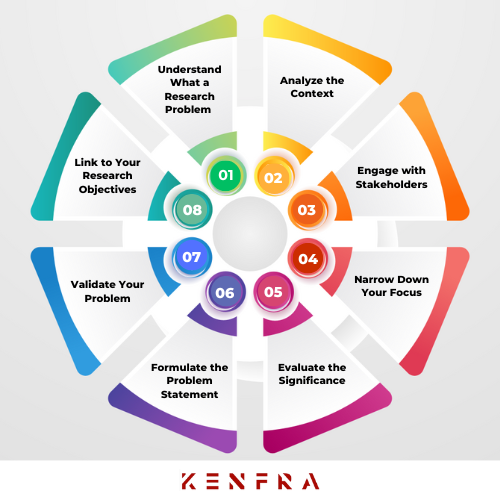14Dec

Research problem identification is the first and most crucial step in conducting impactful research, as research problem identification sets the foundation for your study and determines its relevance, scope, and objectives. Here’s a step-by-step guide on how to effectively identify and articulate a research problem, ensuring that it aligns with academic or practical needs.

A research problem is a specific issue, challenge, or gap in knowledge that needs to be addressed through investigation. It could arise from:
Your research problem should be clear, focused, and significant enough to contribute value to the field.
To identify a research problem, you need to analyze the broader context. Ask questions like:
Conducting a thorough review of existing literature is essential at this stage to understand what has already been studied and where gaps exist.
Engage with practitioners, academics, or communities related to your research area. Stakeholder feedback can help you identify problems that are relevant and urgent. For example:
Broad topics can lead to vague or unfocused research. To narrow down, consider:
For example, instead of studying “climate change,” focus on “the impact of urban heat islands on residential energy consumption.”
Your research problem should be meaningful and impactful. Evaluate its significance by considering:
A well-written problem statement serves as the backbone of your research. It should:
Example Problem Statement: “Despite advances in renewable energy technologies, adoption rates in developing countries remain low due to financial and policy barriers. This research aims to explore innovative financing models and policy frameworks to accelerate renewable energy adoption.”
Before finalizing your research problem, validate it with peers, mentors, or advisors. Their feedback can help refine your focus and ensure your problem aligns with academic or practical priorities.
Once the problem is clearly identified, connect it to your research objectives. For instance:
Writing a research problem identification requires clarity, focus, and relevance. By thoroughly analyzing the context, engaging with stakeholders, and narrowing down your focus, you can craft a research problem identification that lays the groundwork for meaningful and impactful research. Always remember, a well-defined problem is the first step toward finding a solution that truly matters. Start your research journey by identifying the right problem today!
Kenfra Research helps you every step of the way, from identifying your research problem to achieving impactful results.

A PhD is often described as one of the most challenging academic endeavors. It requires years of dedication, research,... read more
AISHE 2021-22: Average enrolment of colleges going down in Odisha All India Survey on Higher Education (AISHE):The All India Survey on... read more

Coding qualitative data with NVivo is one of the most efficient ways to manage and analyze large volumes of non-numeric... read more
"Birla Institute of Technology and Science programme"-BITS explicitly focused on converting PhD research into start-ups. However, it's possible that developments... read more
Uniform speed limits for all kinds of vehicles in city, suggest IIT study - kenfra Indian Institutes of Technology(IIT): The Indian Institutes... read more
Your Teacher or Professor It is crucial to take a step back and consider why your teacher or professor asked you... read more
Devi Ahilya Vishwavidyalaya (DAVV): Devi Ahilya Vishwavidyalaya (DAVV), also known as Devi Ahilya University, is a prominent public university located in... read more

Writing a structured literature review is one of the most important milestones in academic research, especially for graduate students and... read more
ICAR (Indian Council of Agricultural Research) PG and PhD results for 2023 have been declared on the official website icar.nta.nic.in,... read more
WhatsApp us
Leave a Reply